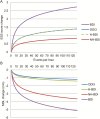Breathing Disturbances Without Hypoxia Are Associated With Objective Sleepiness in Sleep Apnea
- PMID: 29029253
- PMCID: PMC6251661
- DOI: 10.1093/sleep/zsx152
Breathing Disturbances Without Hypoxia Are Associated With Objective Sleepiness in Sleep Apnea
Abstract
Study objectives: To determine whether defining two subtypes of sleep-disordered breathing (SDB) events-with or without hypoxia-results in measures that are more strongly associated with hypertension and sleepiness.
Methods: A total of 1022 participants with 2112 nocturnal polysomnograms from the Wisconsin Sleep Cohort were analyzed with our automated algorithm, developed to detect breathing disturbances and desaturations. Breathing events were time-locked to desaturations, resulting in two indices-desaturating (hypoxia-breathing disturbance index [H-BDI]) and nondesaturating (nonhypoxia-breathing disturbance index [NH-BDI]) events-regardless of arousals. Measures of subjective (Epworth Sleepiness Scale) and objective (2981 multiple sleep latency tests from a subset of 865 participants) sleepiness were analyzed, in addition to clinically relevant clinicodemographic variables. Hypertension was defined as BP ≥ 140/90 or antihypertensive use.
Results: H-BDI, but not NH-BDI, correlated strongly with SDB severity indices that included hypoxia (r ≥ 0.89, p ≤ .001 with 3% oxygen-desaturation index [ODI] and apnea hypopnea index with 4% desaturations). A doubling of desaturation-associated events was associated with hypertension prevalence, which was significant for ODI but not H-BDI (3% ODI OR = 1.06, 95% CI = 1.00-1.12, p < .05; H-BDI OR 1.04, 95% CI = 0.98-1.10) and daytime sleepiness (β = 0.20 Epworth Sleepiness Scale [ESS] score, p < .0001; β = -0.20 minutes in MSL on multiple sleep latency test [MSLT], p < .01). Independently, nondesaturating event doubling was associated with more objective sleepiness (β = -0.52 minutes in MSL on MSLT, p < .001), but had less association with subjective sleepiness (β = 0.12 ESS score, p = .10). In longitudinal analyses, baseline nondesaturating events were associated with worsening of H-BDI over a 4-year follow-up, suggesting evolution in severity.
Conclusions: In SDB, nondesaturating events are independently associated with objective daytime sleepiness, beyond the effect of desaturating events.
Keywords: Outcome Assessment (Health Care); Pattern recognition; automated; sleep apnea syndromes.
© Sleep Research Society 2017. Published by Oxford University Press on behalf of the Sleep Research Society. All rights reserved. For permissions, please e-mail journals.permissions@oup.com.
Figures



References
-
- The Price of Fatigue: The Surprising Costs of Unmanaged Obstructive Sleep Apnea. Boston, MA: McKinsey & Co; 2010.
-
- AlGhanim N, Comondore VR, Fleetham J, Marra CA, Ayas NT. The economic impact of obstructive sleep apnea. Lung. 2008; 186(1): 7–12. - PubMed
MeSH terms
LinkOut - more resources
Full Text Sources
Other Literature Sources
Medical

